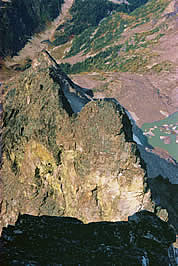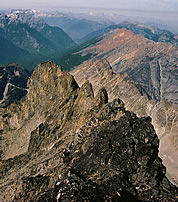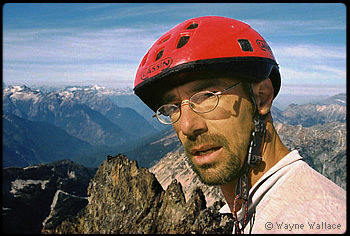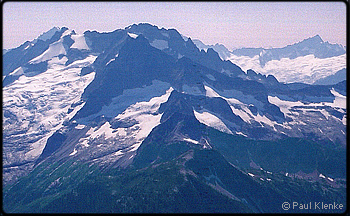 |
 he
following is a story of two forays to Logan that tested my
endurance. The first is a tale of acquainting myself with my physical limits
of climbing in a 24-hour day. I left in the evening of July 31st, expecting
to cover just a few miles. Instead I carried a micro bivy for 15 miles
that Monday before collapsing in a nervous sleep. The ranger lady had me
freaked out
about
bears, and scat was everywhere, proving her point. he
following is a story of two forays to Logan that tested my
endurance. The first is a tale of acquainting myself with my physical limits
of climbing in a 24-hour day. I left in the evening of July 31st, expecting
to cover just a few miles. Instead I carried a micro bivy for 15 miles
that Monday before collapsing in a nervous sleep. The ranger lady had me
freaked out
about
bears, and scat was everywhere, proving her point.
 |
 |
|
View down the NW Ridge of Logan. © Wayne
Wallace. Enlarge |
|
 |
After dreaming of collapsing bridges, I found I had overslept to the “late” hour
of 4:30 in the morning. I still had many miles to go and much elevation to
gain. The bushes were loaded with water from the previous day’s rain.
I tried to knock them dry with a stick, but after a few miles, I resigned
myself to being soaked. The way had heavy debris and was hard to follow.
The climb would have gone more quickly, but a foggy whiteout got me miles
off route. I wished
for any type of a view, but the veil was thick and I felt lucky to have made
it at all.
Logan seemed a remote and seldom-visited mountain; I was surprised
to find myself the apparent first to summit in the 2003 season. The summit
brings another realization. The problem with long approaches is that one
must hike an equally long way out.
Not
excited
about this fact, I took a shortcut on
the way down. This “shortcut” proved to be insane but manageable
with only creative down climbing involved (no rappels).
I didn’t expect to try Mt. Logan in a day until
I glanced at my watch on the way out. (With a little planning, a much shorter
round trip time is quite possible.) Now hot on this idea, I started moving
very fast and at times was flat out running. Never having pushed myself to
that extreme, now witnessing my body break down was interesting. Of course
I had the usual foot pain, but new and terrible things were occurring
too. My quads were actually going numb, and I didn’t know what to make
of the horrendous pelvic pain. It left me glad that males cannot get pregnant.
October came in with nice weather. I was again between jobs and without a
mid-week partner. Feeling restless for adventure, I began looking over topo
maps for something new. My eyes couldn’t believe what I saw on Mt.
Logan: The Northwest Ridge looked to be the biggest and longest ridge feature
in the whole North Cascades. Huge serrated gendarmes soared all along its
mile-long spine. Alan Kearney made an ascent up a face below its north flank
but never even got to the crest of the ridge itself. It truly appeared to
be untouched, and for good reason! Little did I know that I was about to
be tested to my core physically, as on my
first
trip
to Logan, but also mentally.
In my many decades of climbing, I have found no greater reward than going
alone into the unknown. It seems one must really enjoy climbing for climbing’s
sake to choose this way. Remove the comfort and camaraderie of having a partner,
and what remains is just you against yourself and this big scary goal. An
entirely different atmosphere is created. Confidence is the only currency
accepted here. Leave your credit card at home.
 |
 |
|
Back along the NW Ridge of Logan. © Wayne
Wallace. Enlarge |
|
 |
Not willing to let technical difficulties hold me back, I slogged in with
full climbing gear, including a rope, full rack, Soloist, hammer,
and even pitons. Because it was October, I added a sleeping bag, stove, and
bivy
sack. With all of this weight, I was hoping to be able to return to a camp
at the base where I could leave the bivy gear, but I could not even figure
out how to get into the valley to reach the base of the ridge itself! This
gateway to the ridge was the most protected valley I had ever seen,
rimmed on all sides by large cliffs. I put away the topo map, hoping for
a bit of luck.
Heading up the now familiar Thunder Creek was still a beautiful journey.
I decided to leave the trail at Junction Camp, fully knowing a
major bushwhack was ahead. I went light on the water, and was parched when
I reached the ridge, west above the Logan Creek valley. Seeing a lake 400
feet
below did not help; a cliff separated me from its quenching
shores. Further up the ’whack I saw another more reachable lake that
led me to water of course, but also deer tracks that led from the lake
toward the Logan valley. Curious to see where the tracks went, I followed
them to where I could overlook a bizarre triangular fracture in the valley
wall. It seemed the whole side of the valley, for a couple of miles, had
actually collapsed to form two micro-valleys. Here was my luck in accessing
the route:
One fracture led down to the valley proper, and the other led me right up
into the beautiful Logan Creek valley where I could camp and then gain the
base
of the Northwest Ridge. This feature I called “The Wrinkle in Time.” I
found the two valleys stunning despite the ubiquity of bear scat.
I decided a plan to climb and return to camp was impossible, so I carried
a heavy load onto the ridge.
This
Northwest Ridge was the longest of any ridge that I had ever seen in the
lower 48 states. The 4th-class climbing went on and on for hours until rappelling
became necessary
down
the backsides of many of its gendarmes. These pinnacles showed no signs of
human travel as I wrapped sling after sling over them. The pinnacles got
larger and more difficult as I went along. I was growing concerned as less
and less rope was reaching the bottom of each rappel. The last two gendarmes
proved to be the most stressful in terms of difficulty and route finding.
Well past the point of no return now, I was exhausted
and scared shitless — a bad combination. My thoughts were occupied with escape
and survival bordering on desperation. There simply had to be a way up the
thing,
but
the rock was
somewhat loose and offered almost no protection even if I felt the need for
the rope. My hands where jarred from all the hours of thumping on the questionable
holds, and my nerves were shattered when I slipped while down climbing. I
later discovered that I had broken ribs when I slammed my chest into the
rock from the slip.
After 8+ hours of endless climbing I reached the wafer-thin final ridge.
It relented to better rock but overhung slightly and was unbelievably exposed.
Mantling onto the summit ridge brought me to a true knife-edge ridge of shattered
rock and missing blocks. Negotiating it took great care. The summit
meant more to me this 2nd time; I was now released from the grave
danger of the free solo of the very long and stressful climb. I cannot describe
the relief this mountaintop now provided. It felt as
if
the peak
itself had a foot on my heart and my task was to struggle free of its
weight. This Logan rematch left me feeling a special bond
with its lonely mass of rock and snow.
The way out was hindered by my decision not to take crampons. I sketched
along vast glaciers in my tennis shoes worrying about taking “the great
slide.” Twenty miles of trail did their best to work out the remainder
of my reserves on a hike split by a sleepover at the old mine. The
descent was
demanding yet closed a very satisfying trip. I hope you, the reader, can
find adventure and joy in these wild places; perhaps Logan is waiting for
your
feet as well.
Here’s to your trip. Cheers!
|
 |
| summary |
| |
 |
| Mt Logan |
 |
North Cascades National Park
Elevation 9,087 feet
|
 |
| Itinerary |
 |
July 31 to Aug 1, 2003
24-hour climb of the Banded Glacier. |
 |
October 2003
First ascent, solo, of Logan’s complete NW Ridge. |
| |
|
 |




